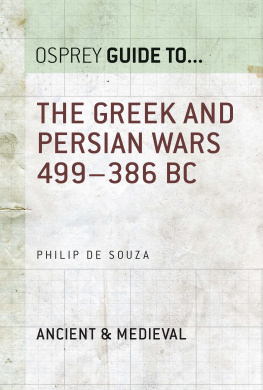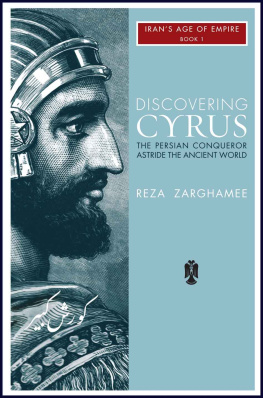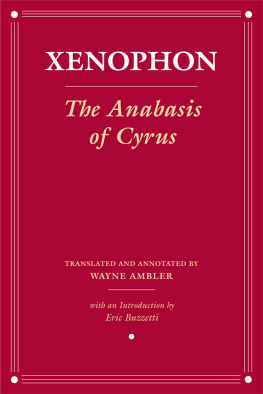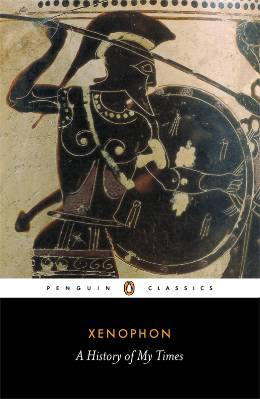XENOPHONS MARCH
XENOPHONS
MARCH
INTO THE LAIR OF THE
PERSIAN LION
JOHN PREVAS
Published by Da Capo Press
A member of the Perseus Books Group
http://www.dacapopress.com
Copyright 2002 by John Prevas
All rights reserved. No part of this publication may be reproduced, stored in a retrieval system or transmitted, in any form or by any means, electronic, mechanical, photocopying, recording or otherwise, without the prior permission of the publisher.
ISBN-13 978-0-306-81117-3; ISBN-10 0-306-81117-0
eBook ISBN: 9780306811173
Da Capo Press books are available at special discounts for bulk purchases in the U.S. by corporations, institutions, and other organizations. For more information, please contact the Special Markets Department at the Perseus Books Group, 11 Cambridge Center, Cambridge, MA 02142, or call (800) 255-1514 or (617) 252-5298 or email
Cataloging-in-Publication data is available from the Library of Congress.
First edition, first printing.
PRINTED AND BOUND IN THE UNITED STATES OF AMERICA.
CHRONOLOGY
| 800-700 B.C. | Iliad and Odyssey of Homer |
| 750-500 B.C. | Greek Archaic Period |
| Solon becomes archon at Athens |
| Peisistratus establishes a benevolent tyranny at Athens |
| Persians conquer Greek cities of Asia Minor (Ionian coastline) |
| Persia conquers Babylon |
| Persians conquer Thrace |
| Cleisthenes establishes democracy in Athens |
| Ionian revolt against Persian rule |
| Miletus destroyed and Ionian revolt crushed by Persia |
| Themistocles becomes archon at Athens |
| Athenians defeat Persians at Marathon |
| Battles of Thermopylae, Artemisium, and Salamis |
| Creation of the Delian League |
| 461-446 | First Peloponnesian War |
| 450s-430s | Prominence of Pericles at Athens |
| Thirty-year peace treaty between Athens and Sparta |
| Second Peloponnesian War begins |
| Plague at Athens; approximate date of Xenophons birth |
| Death of Pericles |
| 415-413 | Athenian expedition to Sicily |
| Oligarchy of the Four Hundred at Athens |
| Democracy restored at Athens |
| Athens surrenders to Sparta |
| 404-403 | Thirty Tyrants rule in Athens |
| Democracy restored in Athens |
| Cyrus undertakes the expedition against Artaxerxes |
| The expedition of the Greeks begins |
| Thibron begins a new war against the Persians; trial of Socrates |
| Xenophon fights with Spartans at battle of Coronea |
| 380s-370s | Xenophon settles in Olympia, later in Corinth |
| Alexander the Great defeats Darius at Issus |
| Alexander enters Babylon |
| Death of Alexander at Babylon |
PREFACE
When I retraced the steps of Xenophon and the Greeks in preparation for this book I found many things throughout Turkey to be remarkably similar to what is described in the ancient Greek and Latin manuscripts. Many of the names of towns and cities through which the mercenaries marched twenty-four hundred years ago can be found today in slightly altered form in the modern town and city appellations. So many place names bear a remarkable similarity to the ancient names and the distances between them correspond almost exactly to the distances described in the ancient sources. There remain many archaeological sites to visit from this period in history. Customs of the people remain unchanged as well. The marketplace still plays a dominant role in the life of every village, town, and city just as it did in ancient times. One can find everything imaginable to purchase there, from silks and spices to tank parts and Viagra. Animals are still sold, slaughtered, and butchered by the roadside in the same manner as they have been for centuries. Women, in the eastern part of the country at least, are still subservient to men and lead lives of hard physical toil.
Vast areas of the Persian Empire in Asia Minor are described in the ancient manuscripts as being a virtual garden. I found that Turkey today is the same garden that is described in those manuscripts and nearly all the work in that garden is still done by hand. From one end of the country to the other the land is a cornucopia of olives, grapes, fruit, and grains that are harvested by villagers. The main road through central Turkey follows the ancient spice route from the orient and today trucks of every size and description haul goods along it just as caravans did centuries ago.
Traveling through the eastern part of Turkey it is disheartening to observe how little some things in that part of the world have improved from the descriptions found in the ancient manuscripts. Poverty and the specter of war still loom over the lives of the common people. Thugs and terrorists control significant sectors of the economy and countryside while progress has added additional burdens to the backs of the poor in the forms of population density and industrial pollution. Among areas of genuine progress, I was impressed with the efforts to which the Turkish government has gone to insure that each village or town, no matter how remote or poor, has a school staffed with teachers and books for the children. While armed soldiers have to escort some of those children to school, and heavily fortified military outposts are in evidence in nearly every town and village, there is a genuine commitment to education of the young in the country.
Terrorists are still a concern in parts of the countryside just as marauding bands were in ancient times. While one is able to tour most of eastern Turkey with minimal hindrance and in relative safety, the borders with Armenia, Iran, Iraq, and Syria can be dangerous and unstable places. In the current political climate it is unfortunately impossible to duplicate the entire trek of Xenophon and the Ten Thousand. Nevertheless, I was able to complete the majority of the route and gain a perspective that proved invaluable in the writing of this book. It is my hope that the reader will enjoy the book as much as I enjoyed researching and writing it.
John Prevas
Washington, D.C.
March 2001
INTRODUCTION
In the eastern part of the ancient Mediterranean world most people were slaves in one way or another. Either they were owned by others in the classic definition of slavery or they were controlled to the point where they had little say over their own lives. Most people paid a high percentage of what little they raised as tribute to emperors, kings, governors, and a host of other petty tyrants and local thugs more powerful than they were. In that way they might be left alone to live out in relative peace what remained of their short lives. Many fell victim to the incessant wars and conflicts that raged throughout the ancient world and few would have reached their natural lifespans. People had a difficult existence in the ancient world that tended, as the philosopher Hobbes once wrote, to be short, nasty, and brutish. It was not, in general, a pleasant time to be alive and nowhere does that statement find greater validity than in the story that will follow in the pages of this book.












